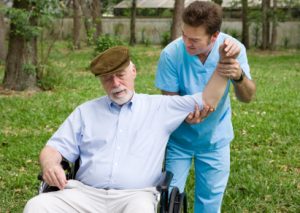 Physical abuse is the use of physical force or violence that causes bodily harm, injury, pain, or impairment to the victim. This can include battery, assault, or any inappropriate use of restraint between two people. Physical abuse can occur at any age and may be repetitive or a singular incident. Due to the nature of nursing homes and assisted living facilities, elderly physical abuse can be difficult to identify.
Physical abuse is the use of physical force or violence that causes bodily harm, injury, pain, or impairment to the victim. This can include battery, assault, or any inappropriate use of restraint between two people. Physical abuse can occur at any age and may be repetitive or a singular incident. Due to the nature of nursing homes and assisted living facilities, elderly physical abuse can be difficult to identify.
Elder Maltreatment
According to the U.S. Centers for Disease Control and Prevention (CDC), elder physical abuse is a form of elder maltreatment. Elder maltreatment is any form of neglect or abuse which occurs to people that are 60 years of age or older. Elder physical abuse may come from a caregiver, an acquaintance, a nurse, doctor, family member, or any other person the elderly patient has contact with. However, according to the U.S. National Committee for the Prevention of Elder Abuse (NCPEA), elder physical abuse perpetrators are most likely to be unmarried, unemployed, and to live with the elderly patient.
Types of Elder Physical Abuse
Forms of elderly physical abuse may include, but are not limited to, the following:
– Scratches
– Bites
– Burns
– Being pushed, hit, shoved, or slapped
– Threats or assault with a weapon, including guns, knives, and other objects
– Inappropriate use of restraint
Indicators of Elder Physical Abuse
Both the CDC and the NCPEA identify a difficulty with defining elder maltreatment and the importance of improving those definitions. This is because elder self-neglect may appear similar to elder maltreatment. However, elder self-neglect is the result of the elderly patient’s own actions. Elder maltreatment is the infliction of abusive behavior by another person. Without a clear definition of elder maltreatment, and indicators of elder abuse, elderly patients are at risk of enduring harm that goes unnoticed.
Behavioral Signs of Elder Physical Abuse
Behavioral indicators of elderly physical abuse include:
– Cigarette burns, scalding burns, or burns from appliances
– Abrasions that resemble injuries from ropes or straps
– Injuries that appear to be healing with “secondary attention,” which may indicate the elderly patient is attempting to treat the injury alone
– Internal injuries that may be identified by pain or malfunctioning organs
– Multicolored or “wrap around” bruises, particularly those encircling an elderly patient’s arms
– Traumatic hair or tooth loss
– Sprains, broken bones, fractures, or dislocated joints
Physical Signs of Elder Physical Abuse
Physical indicators of elderly physical abuse include:
– Delay between the actual injury occurring and the elderly patient seeking medical care
– A history of injuries or hospitalizations, for similar elderly injuries
– A varied or incongruent explanation of how the elderly injury occurred, especially when family members’ stories are not congruent
– Unexplained, or unlikely explanations, of how the elderly patient’s injury happened
– Visits to different medical institutions for injuries, even though the elderly patient has lived in the same area throughout the medical visits
– Tense or strained relationships
– Unexplained withdrawal from typical activities or social interaction that the elderly patient enjoys
Elderly Abuse Statistics
The Assisted Living Federation of America (ALFA) cites elder abuse and maltreatment as a serious problem with elder American health care. ALFA research shows that elderly women and patients over the age of 80 are at the greatest risk of elder abuse. The ALFA research further indicates that patients are at a 300% increased risk of death during the 3 years following any event of elder abuse. ALFA research also indicates that roughly 1 in 6 patients experiencing elder abuse actually report the event. This drastically skews elderly abuse statistics and allows abusive caregivers to continue committing acts of harm against future elderly patients.
Preventing Elder Physical Abuse
Family members of elderly patients in a nursing home or assisted living facility can help prevent elder physical abuse. By visiting often, paying attention to social or behavioral patterns, and keeping an eye on the elderly patient’s health conditions, the risk of elder physical abuse is significantly minimized. Talk to the elderly patient, listen to his or her concerns, and pay attention to any medicine the patient may be taking.
Elderly patients can take their own action to avoid becoming victims of abuse. It is important to ensure that financial obligations are taken care of. Keep in touch with friends and family. If there is something involved in the care an elderly patient is receiving, that he or she does not like, it is important to speak up about it.
Reporting Elderly Abuse
The CDC, NCPEA, and ALFA cite elder abuse as an “invisible” problem, due to many patients’ failure to speak up about elderly abuse. Some elderly patients struggle with dementia or Alzheimer’s disease, making reports of elder abuse even more unlikely. If you or anyone you know is showing signs of elderly abuse, it is important to report the abuse signs to officials immediately.
Sources:
Elder Abuse Facts. Alexandria: Assisted Living Federation of America, Print.
“Physical Abuse.” National Committee for the Prevention of Elder Abuse. N.p., n.d. Web. 18 May 2013. http://www.preventelderabuse.org/elderabuse/physical.html
Robinson, Lawrence, Tina De Benedictius, and Jeanne Segal. “Elder Abuse and Neglect.” Help Guide. N.p., n.d. Web. 18 May 2013. http://www.helpguide.org/mental/elder_abuse_physical_emotional_sexual_neglect.htm
United States. Centers for Disease Control and Prevention. Elder Maltreatment: Definition. 2010. Print. http://www.cdc.gov/violenceprevention/eldermaltreatment/definitions.html
“What is Elder Abuse?.” Administration on Aging. N.p., 01 Apr 2013. Web. 18 May 2013. http://www.aoa.gov/AoA_programs/Elder_Rights/EA_Prevention/whatIsEA.asp&xgt
